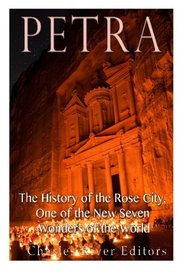Charles Rivers is offering a glimpse of Petra's very long and amazing history. William Burgon, English poet and Dean of Chichester Cathedral, described Petra as "the rose-red city, half as old as time." (p. 7) With the history the author shares about this place, it seems an apt description. Views of al-Siq (a 1200 meter-long canyon with sandstone walls) are often used as wallpaper scenes on computer monitors. It is truly beautiful.
Petra offers a fusion of European, African, Arabian, and Central Asian cultures. On a map, one can see what a critical point Petra would have been for trade and travel. An astounding fact is that only 15% of the area has been excavated by archaeologists. In and around Petra, there is evidence of biface lithics from the Middle Palaeolithic Age (ca. 120,000 - 38,000 years ago). This proves that hunter-gatherers roamed through this area. Gradually, people changed from hunter-gatherers to sedentary agricultural sites.
Various tool types prove that Petra was inhabited through the copper, bronze, and iron ages. Arabians were active in the trade routes as early as the 8th century BCE. Petra was an old place by the time the Romans came. A fascinating fact is that Petra has been damaged by earthquakes over the centuries. Another surprising fact is that by the end of the 13th century, Petra was empty. It remained so for generations.
A good portion of the book is concerned with the problems with modern tourism and protecting the rare and delicate edifices that remain. As usual, some want the tourism dollars, archaeologists want to study, and UNESCO wants to protect it all. Petra is not static; it is subject to flash flooding, seismic activity, weathering, and desertification. Balancing the needs of the inhabitants of Petra, the tourist industry, and protecting it for the future are all weighty problems still to be solved.
Petra offers a fusion of European, African, Arabian, and Central Asian cultures. On a map, one can see what a critical point Petra would have been for trade and travel. An astounding fact is that only 15% of the area has been excavated by archaeologists. In and around Petra, there is evidence of biface lithics from the Middle Palaeolithic Age (ca. 120,000 - 38,000 years ago). This proves that hunter-gatherers roamed through this area. Gradually, people changed from hunter-gatherers to sedentary agricultural sites.
Various tool types prove that Petra was inhabited through the copper, bronze, and iron ages. Arabians were active in the trade routes as early as the 8th century BCE. Petra was an old place by the time the Romans came. A fascinating fact is that Petra has been damaged by earthquakes over the centuries. Another surprising fact is that by the end of the 13th century, Petra was empty. It remained so for generations.
A good portion of the book is concerned with the problems with modern tourism and protecting the rare and delicate edifices that remain. As usual, some want the tourism dollars, archaeologists want to study, and UNESCO wants to protect it all. Petra is not static; it is subject to flash flooding, seismic activity, weathering, and desertification. Balancing the needs of the inhabitants of Petra, the tourist industry, and protecting it for the future are all weighty problems still to be solved.




